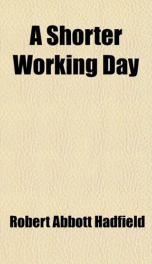a shorter working day

Purchase of this book includes free trial access to www.million-books.com where you can read more than a million books for free. This is an OCR edition with typos. Excerpt from book: CHAPTER II. HISTORY OF THE MOVEMENT IN ENGLAND. [II. De B. G.] Early TimesThorold Rogers' StatementsThomas MoreThe Beginning of the Nineteenth CenturyThe Factory ActsThe Trades Unions AgitationGrowth of the MovementThe New UnionismThe Dundee CongressThe Liverpool and Newcastle CongressesThe May-Day DemonstrationsThe Deputation to Lord SalisburyMr. Gladstone and the Movement. [Appendix : The Interview with Mr. Gladstone.] g 1. Early Times. The movement for a shorter working day is after all no new thing, but rather a recurrence to a state of things which prevailed in earlier centuries. If we are to accept the statements of Professor Thorold Rogers, the artisan and labourer of the fourteenth and fifteenth centuries only worked eight hours per day as a rule, and were paid for overtime. As Professor Rogers' statement has been severely criticized by other economists, it may be well perhaps to give it in his actual words.1 " The winter's wages are about 25 per cent. less than those of other seasons, but the winter seems to have been limited to the months of December and January. This fact, which I have frequently noticed, is proof that the hours of labour were not long. They seem 1 S1. L'e1turifs of rork and Wages, pp. l!o, 542. to have been not more than eight hours per day, and at a later period in the history of labour the eight hours day seems to be indicated by the fact that extra hours are paid for at such a rate as corresponds to the ordinary pay per hour for eight hours, being a little in excess. Hence the artisan, if he were minded to do so, would have time during summer for some ag1icultural employment; it would seem that this occupation for spare time was not unusual, for I have found employers of artisans occasionally purchasing agricultu...
Info about the book
Author:
Series:
Unknown
ASIN:
B003L87UJW
Rating:
4/5 (4)Your rating:
0/5
Languge:
English
Users who have this book
Users who want this book
What readers are saying
What do you think? Write your own comment on this book!
write a commentif you like a shorter working day try:
Other books by this author
Do you want to read a book that interests you? It’s EASY!
Create an account and send a request for reading to other users on the Webpage of the book!

